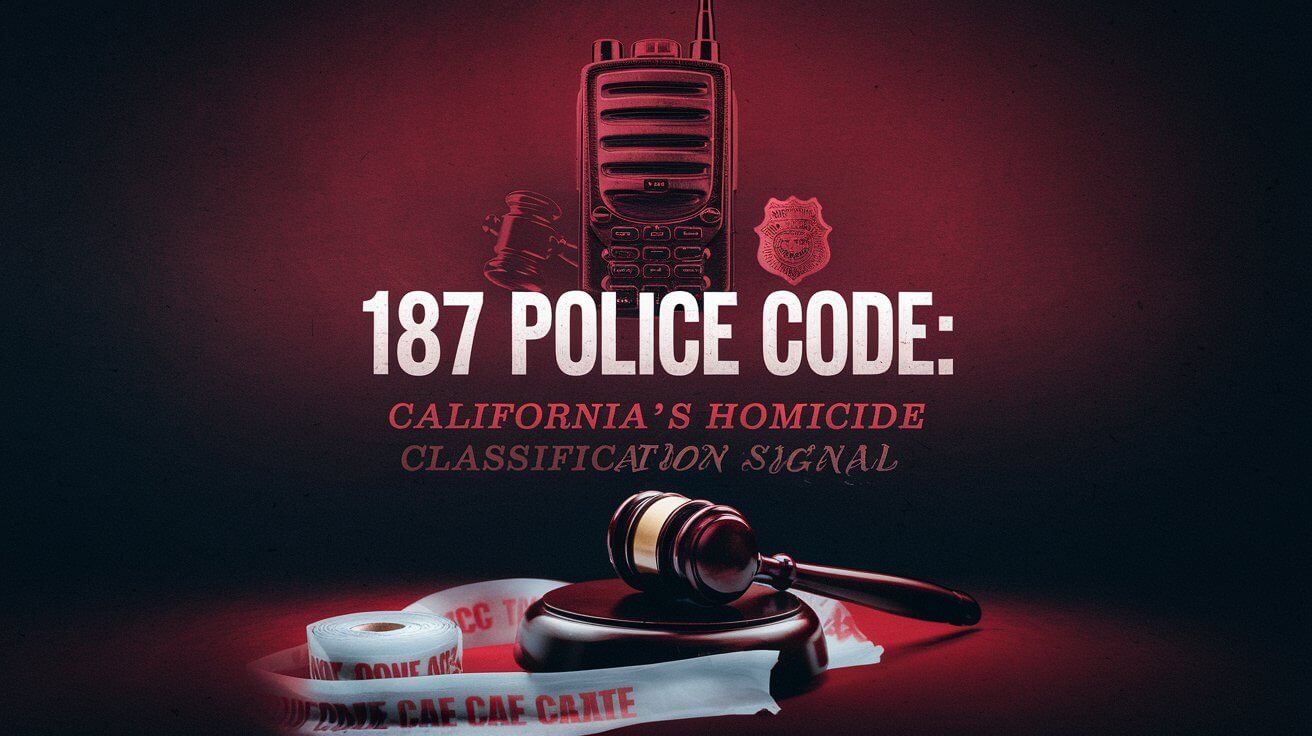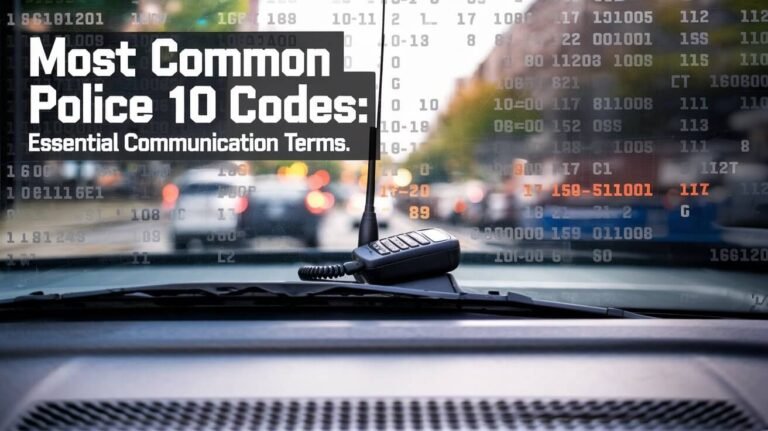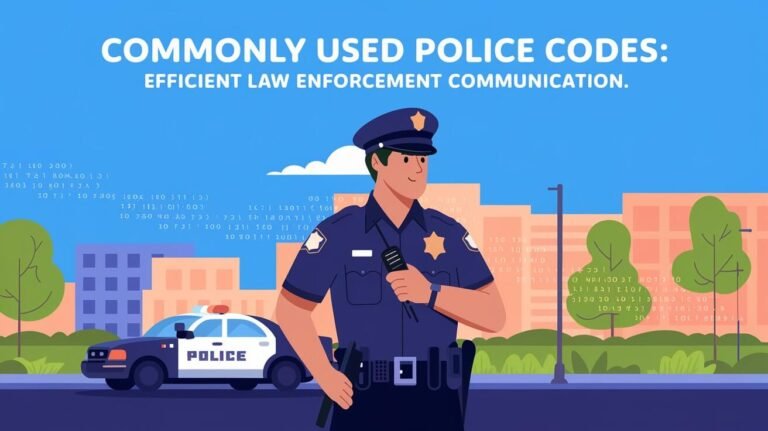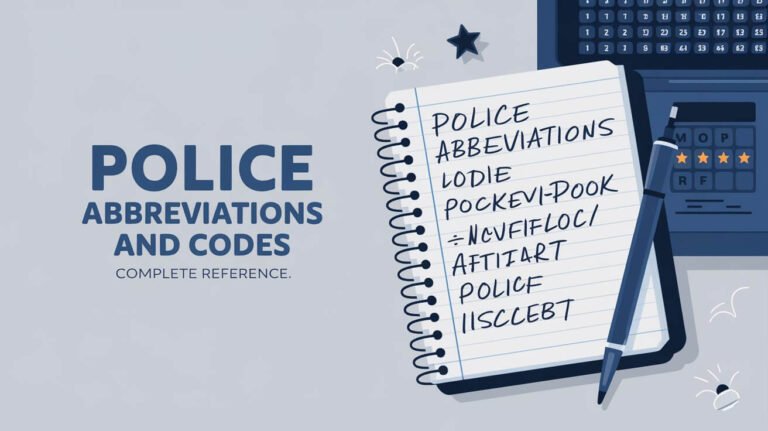187 Police Code: California’s Homicide Classification Signal

The 187 police code is well-known in law enforcement and criminal justice. It comes from Section 187 of the California Penal Code. This section defines murder as the unlawful killing of a human being or fetus.
Police use the 187 code to mark suspected homicide cases. This helps them respond quickly and thoroughly. The code has become a key part of police talk and is also known in popular culture.
History of California Penal Code 187
The roots of California Penal Code 187 go back to 1850, when California became a state. It was added to the law in 1872. Today, it’s one of the oldest parts of California’s law. Over time, it has changed from a legal definition to a key radio code for police.
Origins in California State Law
When California created its penal code, section 187 was included. It made killing a human being a crime. The language has changed, but its main goal remains the same.
Evolution of the Code’s Usage
California Penal Code 187 has also become a cultural symbol in law enforcement. It’s a shorthand code for police to signal a murder or homicide. This has made the code a part of police work and language.
Implementation in Law Enforcement
The use of “187” as a radio code has made it a key part of California’s justice system. It helps officers quickly alert others to a serious crime. This has made 187 a central part of how police handle violent crimes.
| Penal Code Section | Description | Penalty |
|---|---|---|
| 187 – Murder | Unlawful killing of a human being | First-degree murder: 25 years to life in prison Second-degree murder: 15 years to life in prison |
| 192 – Manslaughter | Voluntary: Sudden intense passion or provocation Involuntary: Negligent or reckless behavior | Voluntary: Up to 11 years in prison Involuntary: Up to 4 years in prison |
| 191.5 – Vehicular Manslaughter | Unintentional killing in an automobile accident | Varies based on circumstances |
Legal Definition and Components
In California, murder is defined as the unlawful killing of a human being or fetus with malice aforethought. Malice aforethought means either intent to kill or reckless indifference to human life. The law also has exceptions for legal abortions and certain medical procedures.
The three main elements in a murder case are:
- The accused caused the death of another person or fetus.
- The accused acted with malice aforethought, which can mean either intent to kill or reckless disregard for human life.
- The accused did not have a lawful excuse or justification for their actions.
Depending on the case, murder can be either first-degree or second-degree. First-degree murder gets a minimum of 25 years to life in prison. Second-degree murder can get a 15-year to life sentence.
In some cases, murder can become a capital offense. This can lead to the death penalty or life without parole. Factors that can increase sentences include the weapon used and if the defendant is a repeat offender.
187 Police Code and Modern Law Enforcement
In today’s law enforcement, the “187” police code is key for quick communication. It comes from the California Penal Code for murder. It helps officers report suspected homicides or deadly force incidents fast.
Radio Communication Protocols
When an officer spots a 187 situation, they send the code to dispatch. This starts a fast response and investigation. The code marks crime scenes, sets case numbers, and quickly tells responders about the incident.
Digital radios and computer-aided dispatch (CAD) make 187 code use better. These tools help send clear, precise messages. This cuts down on mistakes and ensures info gets out quickly and right.
Department Integration Methods
Police agencies have detailed plans for using the 187 code. Dispatchers learn to use these codes fast and well. This makes sure 187 incidents get the urgent attention they need.
The 187 code isn’t just for radios; it’s used in computers, phones, and more. This wide use helps law enforcement work together better. It makes responding to homicides or deadly force quicker and more efficient.
| Police Code | Meaning | Response Priority |
|---|---|---|
| 187 | Homicide | Immediate, high-priority |
| 211 | Armed Robbery | Immediate, high-priority |
| 10-50 | Motor Vehicle Accident | Routine, non-emergency |
Criminal Prosecution Under PC 187
Prosecution under California Penal Code (PC) 187, also known as the “murder charges” statute, aims to prove murder beyond a reasonable doubt. The penalties reflect the crime’s severity. First-degree murder can get you 25 years to life in prison. In special cases, it could even lead to the death penalty.
First-degree murder in California can get you 25 years to life in prison. Second-degree murder gets you 15 years to life. In some cases, you might face capital murder charges, which could mean the death penalty. DUI murder, or “Watson murder,” has the same penalty as second-degree murder.
A lawyer might try to lower first or second-degree murder charges to manslaughter. This could mean a plea bargain for involuntary or voluntary manslaughter. This could lessen the charges and the possible sentence.
Also, a murder conviction under PC 187 counts as a strike under California’s “Three Strikes” law. Getting three strikes for murder convictions can mean a 25 years to life sentence.
| Offense | Penalty |
|---|---|
| First-Degree Murder | 25 years to life in prison |
| Second-Degree Murder | 15 years to life in prison |
| Capital Murder (Aggravated Murder) | Life imprisonment without parole |
| Felony Murder | Same as first or second-degree murder |
| DUI Murder (“Watson Murder”) | Same as second-degree murder |
First-Degree vs Second-Degree Murder Classifications
Understanding the difference between first-degree and second-degree murder is crucial in criminal law. These classifications in California’s Penal Code 187 have big legal and penalty effects for those who commit them.
Distinguishing Factors
First-degree murder, as defined in PC 187(a), means the killer planned and thought about it. They had a clear intent to kill and planned the crime. On the other hand, second-degree murder is about killings that weren’t planned. The killer didn’t have a clear intent to kill.
Penalty Differences
The penalties for these crimes are very different. First-degree murder can lead to life in prison without parole or even the death penalty. Second-degree murder, though, usually means a sentence of 15 years to life in state prison.
Legal Precedents
California’s courts have set rules to help decide which murder charge to use. For example, if a murder was against a peace officer or during a felony, it might be first-degree. The idea of “malice aforethought” is also key in figuring out the murder degree.
| Murder Classification | Defining Characteristics | Potential Sentence |
|---|---|---|
| First-Degree Murder | Premeditated and deliberate intent to kill | Life imprisonment without parole or death penalty |
| Second-Degree Murder | Unpremeditated killings, no deliberate intent to kill | 15 years to life in state prison |
Special Circumstances in 187 Cases
In California’s criminal justice system, Penal Code 187 (PC 187) is key. It defines murder and lists special circumstances that make a murder charge more serious. These factors can lead to harsher penalties, like the death penalty or life without parole.
One special circumstance is murder for financial gain. If someone kills for money, it’s considered a special circumstances murder. Using explosive devices or killing to avoid arrest or conviction are also special circumstances.
| Special Circumstance | Description | Potential Penalty |
|---|---|---|
| Murder for financial gain | Killing someone for money | Life in prison without parole or death penalty |
| Use of explosive devices | Using bombs or destructive devices to kill | Life in prison without parole or death penalty |
| Murder to avoid arrest | Killing to avoid being caught for another crime | Life in prison without parole or death penalty |
| Multiple murders | Committing more than one murder at once | Life in prison without parole or death penalty |
California Penal Code Section 190.2 lists these special circumstances. They make a murder charge more serious. Prosecutors must prove these factors beyond doubt to seek the death penalty or life without parole. These rules help ensure the death penalty is not used unfairly.
Cultural References and Media Impact
The 187 code has become a big part of pop culture. It’s known as a shorthand for murder or homicide. It shows up in music, movies, and TV, showing its lasting effect on how we see things.
Music Industry Integration
In gangster rap, the 187 code is everywhere. Artists like Ice-T and Dr. Dre use it in their songs. This has made the code a symbol of urban crime and violence, connecting with listeners everywhere.
Film and Television Appearances
The 187 code also pops up in crime dramas and police shows. Movies like “Training Day” and TV series like “Dragnet” use it. These shows help us understand the code’s importance, mixing reality with fiction.
The 187 code is known far and wide, thanks to media. It’s a key part of gangster rap, crime dramas, and more. It shows how this California Penal Code section has shaped our culture.
Law Enforcement Training and Code Usage
Police officers learn a lot about communication during their training. They learn about different codes, like the 187 police code. This is a key part of their education and work.
The idea of brevity codes started in 1935. The APCO 10 Signals came out in 1937. These codes, including the 187 for murder, are now a big part of police work in the U.S., mainly in California.
- Important emergency response codes include “10-33” for an officer needing immediate help and “10-78” for requesting backup in tense situations.
- Location and positioning codes like “10-20” tell where an officer is, while codes like “10-6” and “10-7” update an officer’s status.
- Codes for emergency assistance include “10-33” for emergency situations, “10-50” for when an officer is hurt, and “10-56” for when an officer is shot.
In 2006, the U.S. government suggested stopping the use of 10 codes. But many police departments keep using them. This helps them communicate clearly in urgent situations.
Learning the 187 police code and other protocols is vital for police. It helps them stay ready and work well together in tough times. This training prepares them to keep their communities safe.
Criminal Defense Strategies in 187 Cases
When someone is charged with Penal Code 187, also known as the “187 police code,” they need a strong defense. A skilled legal team is key to protect the accused’s rights in this complex legal world.
Common Defense Approaches
One main strategy is to question the prosecution’s evidence. Lawyers might look closely at the investigation, doubt eyewitnesses, and challenge the prosecution’s story. They might also push for a lesser charge, like manslaughter, if the case doesn’t fully support a murder conviction.
Another tactic is to prove an alibi. If the defendant can show they were somewhere else at the time of the crime, it can weaken the prosecution’s case. This could lead to a not-guilty verdict.
Legal Representation Requirements
For murder charges, having a good lawyer is vital. Criminal lawyers with lots of experience in murder defense and legal strategies are best. They know how to handle the legal system, talk to prosecutors, and defend their clients well.
People charged with Penal Code 187 have the right to a lawyer. Without proper legal representation, the consequences can be severe. This includes long prison sentences or even the death penalty in some cases.
| Legal Representation Factors | Importance |
|---|---|
| Experience in Penal Code 187 cases | Crucial for understanding the nuances of murder defense and developing effective strategies |
| Knowledge of evidentiary requirements | Vital for challenging the prosecution’s case and presenting a strong defense |
| Negotiation skills with prosecutors | Can lead to favorable plea bargains or reduced charges |
| Courtroom expertise | Necessary for effectively presenting the defendant’s case at trial |
Investigative Procedures and Protocols
When a 187 police code is reported, a series of steps is set in motion. The main goal is to secure the crime scene, gather and keep important evidence, talk to witnesses, and do detailed forensic tests. Homicide detectives usually lead these complex cases, working with many law enforcement and forensic experts.
The first step is to make sure the crime scene is safe and the evidence is not messed with. Police officers carefully document the scene, take photos, and collect any physical evidence. This can include fingerprints, DNA, weapons, and other key items that help solve the case.
- They also talk to witnesses to get their accounts of what happened and any details that might help figure out the events.
- Forensic experts then analyze the evidence, using advanced methods like ballistic analysis, toxicology tests, and crime scene reconstruction.
- Investigators use the crime scene investigation, forensic evidence, and witness statements to build a strong case for detective work and possible prosecution.
The steps taken for a 187 police code are to make sure the investigation is thorough and careful. By keeping the crime scene safe, collecting evidence, and doing deep interviews, police can build a strong case. This case can then be used in court to prove the truth and bring justice.
Closing Summary
The California Penal Code section 187, known as the “187 police code,” has grown beyond its legal roots. It is now a key part of law enforcement and popular culture. This code defines murder as the unlawful killing of a human being or a fetus. It shows how serious homicide cases are and their big impact on society.
Legal effects of the 187 code are broad. It guides how police handle murder cases. It also shapes the criminal justice system, including special circumstances murder cases. This shows how complex and detailed homicide prosecutions can be.
Cultural impact of the 187 code is clear in media like music, film, and TV. This shows how much the public is interested in and knows about violent crimes. It also highlights the criminal justice system’s role in tackling these issues.






